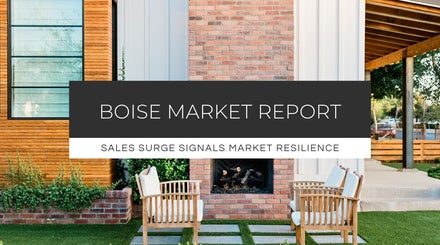
Ada County home prices rose to a new record in May, with the cost of the typical home climbing above $600,000 for the first time.
With the supply still well below normal, homes across the valley are selling at breakneck speed. Half of all listings are on the market for less than a week, the second fastest pace for May in history.
The median single-family home sale price in Ada County finished the month at $602,250, increasing by $84,035 (16.22%) over the last 12 months. In Canyon County, the cost of the typical home rose by $52,735 (12.95%) to $459,990, the second-highest price ever recorded.
While spring is traditionally the busiest time of the year, rising home prices and mortgage rates have created a strong sense of urgency among would-be buyers concerned about higher financing costs and continually higher priced homes.
From years of underbuilding to a new generation of buyers entering the market to a change in people’s priorities in where they choose to live, the factors that got us here continue to impact local home buying.
Even though rising interest rates have made homes less affordable than they were even at the beginning of the year, there is still a legitimate mismatch between supply and demand.
Another side effect of quickly increasing mortgage rates and a tight housing market is fewer new listings. Homeowners locked in at below-market interest rates don’t want to trade them for the higher monthly payments that would come with a move. With people not trading up, even fewer low and mid-priced resale homes are available.
The total number of houses for sale rose to 1,308 in Ada County and 755 in Canyon County. While that is a noticeable increase from 2021, it’s the second lowest number of available listings in Ada County in May since the 1990s.
The cities of Boise, Eagle, and Star also saw new price records in May:
- Boise’s median home price has reached $585,475, increasing $101,375 (20.94%) from a year ago.
- After prices rose by $164,886 (20.11%), Eagle finished the month at $985,000, setting itself up to be the Treasure Valley’s first “million-dollar” city.
- Star home prices jumped to $639,900, an increase of $114,900 (21.89%).
- In booming Meridian, prices rose $54,540 (10.28%) from the year prior to $584,990.
- The cost of the typical home in Nampa increased to $450,000, a gain of $49,500 (12.36%).

After hitting a multi-year high of 5.3% 3 weeks ago, the average 30-year fixed mortgage rate has steadily declined to 5.09%–still the highest we have seen in nearly a decade.
Most of the properties recorded as sold in May were listed in late March and April, making this the first month we have felt the full effects of 5% mortgage rates. Despite higher purchase costs making properties less affordable, the fact that homes are continuing to sell quickly for new records suggests the strength of our local market and the incredible imbalance between supply and demand.
The month’s supply of homes for sale at the end of May was 1.48 and 1.46 in Ada County and Canyon County, respectively. While these are higher amounts than at this time last year, a supply of fewer than two months suggests we are still in an extreme seller's market.
That being said, demand is not what it used to be. The Federal Reserve began raising interest rates in March, and it is clearly having an impact. At the beginning of 2021, our estimates showed there were 10, or more, buyers for every listing. At the beginning of this year, it still wasn’t unusual for the most desirable homes to receive 3 or 4 offers. Today, there are closer to 1 to 2 potential buyers for every home. It’s still a seller’s market, but one moving closer to balance.
This Isn’t a Normal Real Estate Market
Quickly rising home values feel good for homeowners, but 20%+ price increases are neither typical nor sustainable. Even in a very fast-growing market like the Treasure Valley’s, long-term price appreciation averages closer to 5-6%.
The pandemic caused people to rethink their priorities. Many decided where and how they lived was more important than ever before. This realization encouraged people to move up their decision to purchase a home. You could make the case that the last couple of years of price appreciation borrowed from future appreciation.
Having spent the last few years in an extreme seller’s market, many people (and even some real estate professionals) have forgotten what a healthy balanced market looks like.
A balanced market is one where the least sought-after homes take many months to sell, likely with a price cut or two. Properties that are overpriced, in an undesirable location, have unusual layouts, need updating, or are in less-than-stellar condition will take a long time to sell, as they should. Likewise, the most coveted homes will remain on the market for 3 to 4 weeks (instead of days or hours) before receiving an offer slightly below asking price. In a truly balanced market, most listings will fall somewhere in between.
That’s a normal, healthy market.
While we are likely to remain in a seller's market for the foreseeable future, it's clear that we are moving away from the extreme seller's market we have seen over the past few years.
Even if it's not apparent in the reported numbers yet, the signs point to a stabilizing market.
The pandemic pulled some buyer demand forward. It doesn't matter how low interest rates remain or how strong the job market is; there will be less demand for homes as fewer people will move in the next few years than in the last few.
Does Inflation Help or Hurt the Homeowner?
Famed investor Warren Buffett has said that inflation swindles the stockholder. This may be true of the investor, yes, but what about the homeowner?
First of all, what's the alternative–renting?
Rent rises with inflation, just like home values. You might think being a local homebuyer is tough, but Ada County rent has risen by 50% in the last 3 years.
When you own a home, your mortgage payment is fixed. Regardless of inflation, your payment never increases (provided you have a fixed rate loan).
At the same time, inflation makes loan balances easier to repay. How, might you ask? Inflation causes money to lose value over time. While that is typically not a good thing, it is when it comes to making payments on old loans.
Inflation allows you to pay your lender back with money that’s easier to earn than it was when you originally borrowed it.
Part of what’s driven inflation higher is record low employment and rising wages. Those fortunate enough to have good-paying, steady jobs have a fixed mortgage payment with an ever-increasing paycheck.
Inflation helps the homeowner and swindles the renter.
Boise Real Estate Market Summary for May 2022
- Median list price - $575,000 (up 22.02%)
- Median sold price - $585,475 (up 20.94%)
- Price per square foot - $346 (up 16.50%)
- Total home sales - 368 (down 39)
- Median days on market - 5 days (up 0 day)
- Available homes for sale - 1.32 month supply (up 0.79)
- 30-year mortgage rates - 5.23% (up 2.27)
Boise Metro Housing Markets by Area
- Ada County - $602,250
- Eagle - $985,000
- Garden City - $414,000
- Kuna - $490,570
- Meridian - $584,990
- Star - $639,900
- Canyon County - $459,990
- Caldwell - $425,720
- Middleton - $540,429
- Nampa - $450,000
More From Our Blog
Information in this We Know Boise market report was obtained from the Intermountain MLS (IMLS) on June 6th, 2022. Deemed reliable but not guaranteed. City data refers to single-family homes on less than one acre, while county data includes homesites of all sizes. Current inventory is calculated on a twelve-month rolling average. Combining existing homes for sale with new construction is the best way to gauge current home prices and Boise housing market trends. New house prices are much more volatile and can create unreliable comparisons, particularly on a month-to-month basis.
Posted by Lisa Kohl on






Leave A Comment